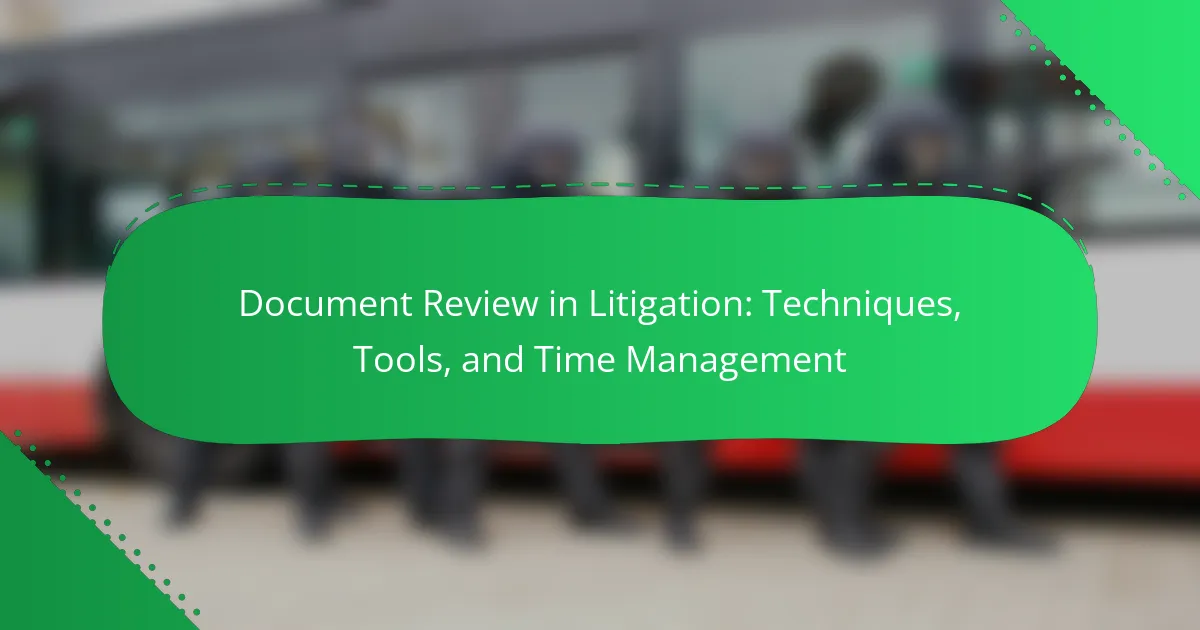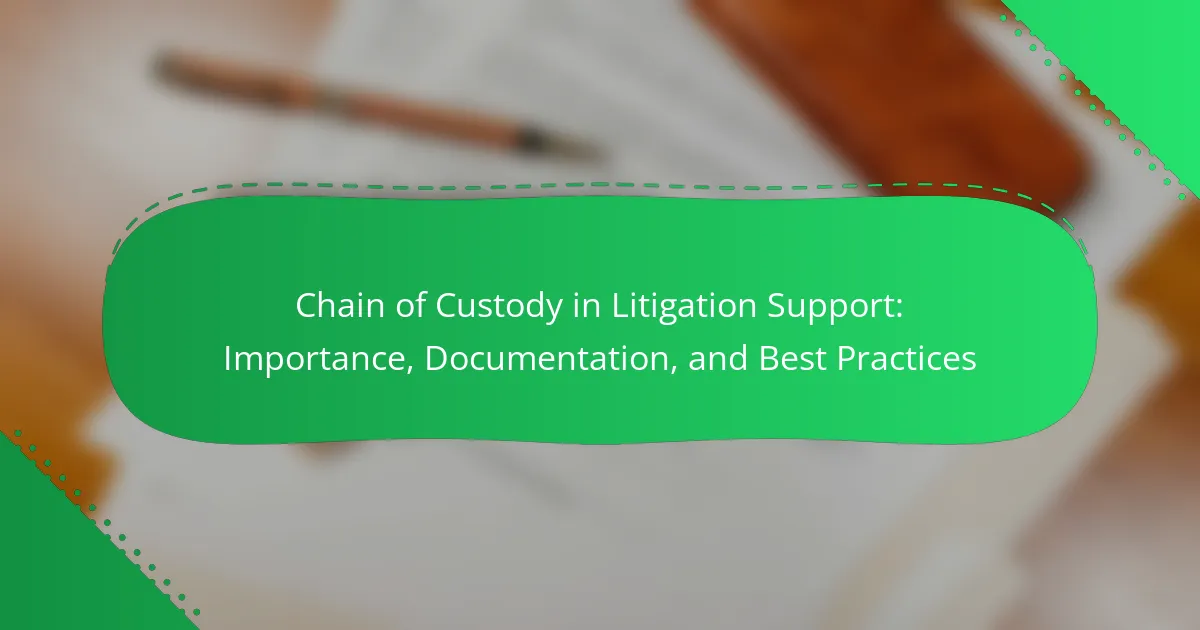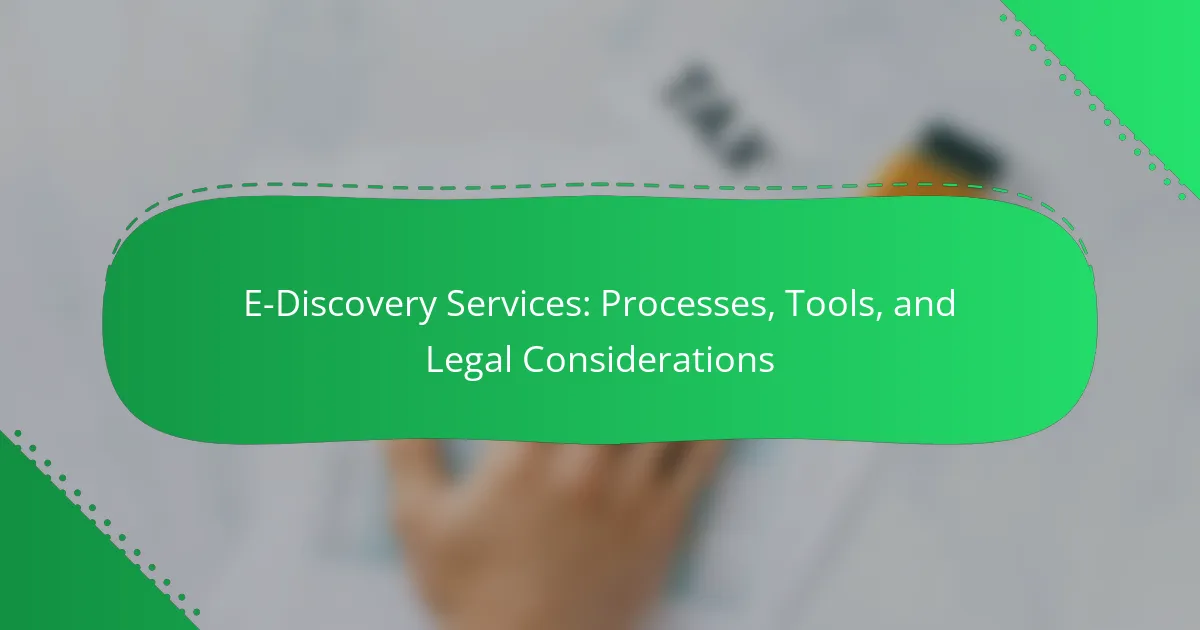Document review in litigation is a critical process involving the examination and analysis of documents relevant to legal cases. This article explores the techniques, tools, and time management strategies essential for effective document review. Key challenges include handling large volumes of documents, understanding complex legal language, and maintaining data security. The article highlights the importance of structured workflows, advanced technology, and regular training to optimize the document review process. Additionally, it emphasizes the role of data analytics in improving review performance and consistency across legal teams.
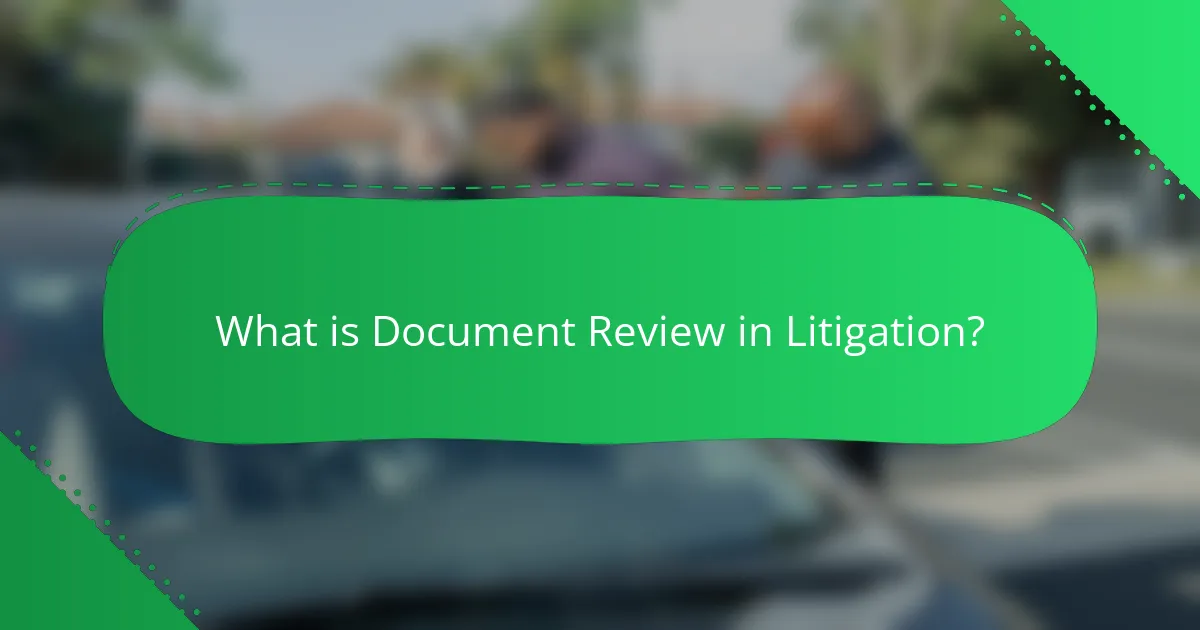
What is Document Review in Litigation?
Document review in litigation is the process of examining and analyzing documents relevant to a legal case. This process is essential for identifying pertinent information, evidence, and insights that can support legal arguments. Document review typically involves sifting through various types of documents, including emails, contracts, and reports. Legal teams utilize both manual and automated tools to enhance efficiency during this process. The goal is to ensure that all relevant materials are considered before trial. Effective document review can significantly impact the outcome of litigation by revealing critical evidence.
How does Document Review play a role in the litigation process?
Document review is a critical step in the litigation process. It involves examining legal documents to identify relevant information. This process helps attorneys build their case by uncovering evidence. Document review can also reveal inconsistencies in testimonies. Proper document review ensures compliance with legal standards. It aids in the preparation of motions and discovery requests. Efficient document review can save time and reduce costs. Studies show that thorough document review increases the likelihood of favorable outcomes in litigation.
What types of documents are typically reviewed during litigation?
Documents typically reviewed during litigation include pleadings, discovery documents, and evidence. Pleadings are formal documents filed with the court, outlining the claims and defenses. Discovery documents encompass interrogatories, requests for production, and depositions. Evidence includes contracts, emails, and other relevant communications. These documents are essential for building a case and understanding the positions of both parties. The review process helps identify key facts and legal arguments. Courts often require thorough documentation to support claims and defenses.
Why is Document Review crucial for case outcomes?
Document review is crucial for case outcomes because it ensures that all relevant information is identified and analyzed. This process helps in building a strong legal strategy. Thorough document review can uncover key evidence that supports a client’s position. It also aids in identifying weaknesses in the opposing party’s case. According to the American Bar Association, over 70% of cases are resolved through settlements influenced by document review findings. Effective document review minimizes risks of surprises during litigation. It enhances compliance with legal standards and procedural requirements. Ultimately, a well-executed document review can significantly impact the final judgment or settlement terms.
What are the common techniques used in Document Review?
Common techniques used in document review include keyword searching, manual review, and technology-assisted review. Keyword searching allows reviewers to quickly locate relevant documents based on specific terms. Manual review involves human analysts examining documents for relevance and privilege. Technology-assisted review utilizes algorithms and machine learning to enhance efficiency. These techniques streamline the review process and improve accuracy. Studies show that technology-assisted review can reduce review time by up to 50%. This efficiency is crucial in litigation, where time and resources are often limited.
How do keyword searches enhance Document Review efficiency?
Keyword searches enhance document review efficiency by allowing reviewers to quickly locate relevant information. This targeted approach reduces the time spent sifting through large volumes of documents. Instead of manually reading each document, reviewers can input specific terms to find pertinent content. Studies indicate that keyword searches can cut review time by up to 80%. This efficiency is crucial in litigation, where time is often limited. Additionally, keyword searches help identify patterns and trends in data that may be relevant to a case. By streamlining the review process, legal teams can focus on strategy and analysis rather than on document retrieval.
What is the significance of predictive coding in Document Review?
Predictive coding significantly enhances document review efficiency in litigation. It employs machine learning algorithms to categorize and prioritize documents. This technology reduces the volume of documents requiring manual review. Studies indicate that predictive coding can improve accuracy in identifying relevant documents. For instance, a study by the RAND Corporation found that predictive coding can achieve over 90% accuracy in document classification. This method also shortens the time needed for document review, allowing legal teams to focus on critical tasks. By automating routine aspects of document review, predictive coding optimizes resource allocation and reduces costs.
What tools are available for Document Review?
Document review tools include various software and platforms designed to streamline the review process. Popular tools are Relativity, Logikcull, and Everlaw. These tools offer features like document organization, tagging, and searching capabilities. They help legal teams manage large volumes of documents efficiently. Some tools provide AI-powered analytics for faster review. Others integrate with existing case management systems. The use of these tools can significantly reduce review time and improve accuracy. Research shows that using specialized software can enhance productivity by up to 40%.
Which software solutions are most effective for Document Review?
The most effective software solutions for document review include Relativity, Logikcull, and Everlaw. Relativity is widely recognized for its robust features and scalability. It offers advanced analytics and machine learning capabilities for efficient document sorting. Logikcull simplifies the process with its user-friendly interface and automated workflows. It helps in quick data uploads and streamlined review processes. Everlaw combines document review with project management tools, enhancing collaboration among teams. These software solutions are backed by user testimonials and industry reviews, highlighting their effectiveness in legal settings.
How do collaboration tools facilitate Document Review in teams?
Collaboration tools facilitate document review in teams by enabling real-time communication and feedback. These tools allow multiple team members to access and edit documents simultaneously. This simultaneous access reduces the time needed for revisions and approvals. Features like version control help track changes and maintain document integrity. Additionally, comment and annotation functions streamline discussions directly within the document. This integration minimizes the need for lengthy email chains. The use of task assignments ensures accountability among team members. Overall, collaboration tools enhance efficiency and accuracy in the document review process.
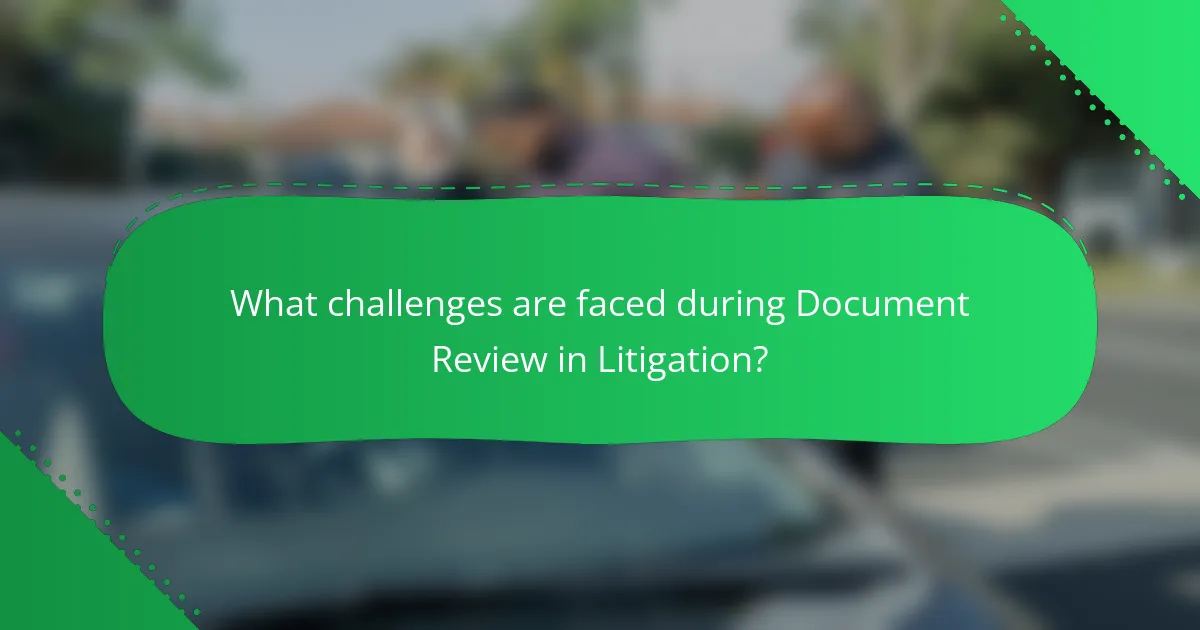
What challenges are faced during Document Review in Litigation?
Document review in litigation faces several challenges. One significant challenge is the sheer volume of documents. Large cases can involve millions of documents, making it difficult to manage and review effectively. Another challenge is the complexity of legal language and terminology. This can lead to misunderstandings or misinterpretations during the review process. Additionally, time constraints often pressure legal teams to complete reviews quickly. This can result in oversight or errors. Maintaining consistency in review standards is also challenging. Different reviewers may interpret documents differently, leading to inconsistencies. Furthermore, the need for technology integration presents challenges. Not all teams are equipped with the latest tools for efficient document management. Lastly, ensuring data security and confidentiality during the review process is crucial. Breaches can lead to serious legal repercussions.
How can time management impact Document Review effectiveness?
Time management significantly enhances document review effectiveness by ensuring timely completion of tasks. Effective time management allows reviewers to allocate sufficient time to analyze documents thoroughly. It reduces the likelihood of errors caused by rushed reviews. Studies indicate that structured time allocation improves focus and productivity. For instance, a report by the American Bar Association found that organized time management strategies can decrease review time by up to 30%. This efficiency not only saves costs but also improves the quality of the review. Therefore, implementing strong time management practices is crucial for successful document review in litigation.
What strategies can be employed to improve time management during Document Review?
Prioritizing tasks is a key strategy to improve time management during document review. Break down the review process into smaller, manageable segments. Assign deadlines to each segment to maintain a steady pace. Utilize technology tools for document organization and search capabilities. Implement a checklist to track progress and ensure all documents are reviewed. Schedule regular breaks to maintain focus and avoid fatigue. Collaborate with team members to distribute workload effectively. Set specific goals for each review session to enhance productivity. Regularly assess and adjust strategies based on progress and challenges encountered.
How does the volume of documents affect time management practices?
The volume of documents significantly impacts time management practices. High document volumes can lead to increased workload and longer review times. This can overwhelm individuals and teams, causing potential delays in the litigation process. Effective time management becomes crucial to prioritize tasks and allocate resources efficiently. Studies show that managing large volumes of documents requires systematic approaches, such as categorization and automation. For instance, utilizing document management software can streamline the review process. Additionally, setting clear deadlines helps maintain focus and productivity. Overall, the volume of documents necessitates strategic planning in time management to ensure timely outcomes in litigation.
What are the best practices for conducting Document Review?
The best practices for conducting document review include establishing a clear review protocol. This protocol should outline objectives and criteria for document relevance. Reviewers must be trained on these criteria to ensure consistency. Utilizing technology, such as document management software, can enhance efficiency. Regular communication among team members is essential for addressing questions and clarifying expectations. Implementing a quality control process can help identify errors early. Documenting the review process ensures transparency and accountability. These practices improve the overall effectiveness of document review in litigation.
How can a structured review process enhance Document Review quality?
A structured review process enhances Document Review quality by providing a systematic approach to evaluating documents. This method ensures consistency in the review criteria applied across all documents. It minimizes the risk of overlooking critical information or inconsistencies.
Additionally, a structured process allows for better tracking of progress and identification of issues. This can lead to more efficient use of time and resources. According to a study by the American Bar Association, structured reviews can increase accuracy by up to 20%.
Implementing checklists and predefined guidelines further supports thoroughness in the review. This structured approach ultimately results in higher quality outputs and improved case outcomes.
What role does training play in effective Document Review?
Training is essential for effective document review. It equips reviewers with the necessary skills to analyze and assess documents accurately. Proper training enhances understanding of legal standards and relevant regulations. Reviewers learn to identify key information quickly and efficiently. This reduces the risk of overlooking critical details. Additionally, training familiarizes reviewers with specific tools and technologies used in document review. A study by the American Bar Association found that well-trained teams can reduce review time by up to 30%. Ultimately, training leads to higher quality outcomes in document review processes.
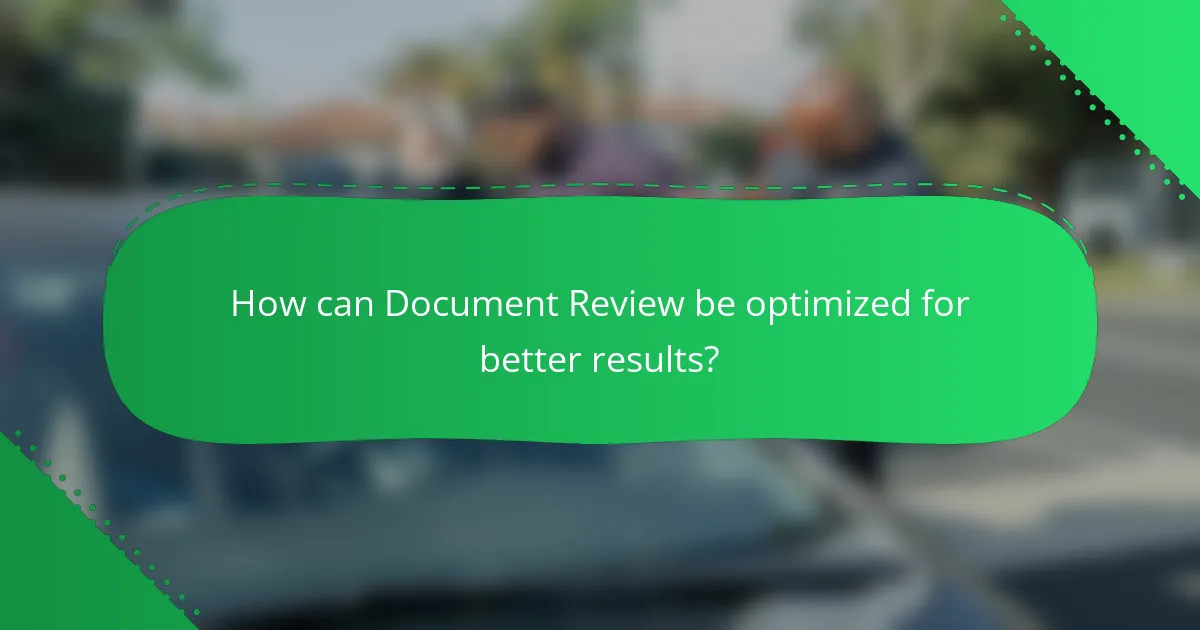
How can Document Review be optimized for better results?
Document review can be optimized for better results by implementing structured workflows and utilizing advanced technology. Structured workflows ensure consistent processes across teams. This reduces errors and enhances efficiency. Advanced technology, such as AI-powered tools, automates repetitive tasks. Automation speeds up the review process and improves accuracy. Training team members on best practices is also crucial. Well-trained reviewers are more effective and make fewer mistakes. Regular audits of the document review process help identify areas for improvement. Data analytics can provide insights into performance metrics. These metrics guide adjustments to enhance future reviews.
What innovative approaches can be applied to Document Review?
Innovative approaches to Document Review include the use of artificial intelligence and machine learning. These technologies can automate the identification of relevant documents. They improve efficiency by reducing the time spent on manual reviews. Predictive coding is another innovative method that prioritizes documents based on their relevance. This technique leverages algorithms to learn from previous decisions made by reviewers.
Collaboration tools enhance team communication during the review process. Cloud-based platforms allow multiple reviewers to access documents simultaneously. This fosters real-time collaboration and reduces turnaround times. Additionally, visual analytics can provide insights into document relationships and trends. This approach helps reviewers focus on critical areas of interest.
Using data analytics can also identify patterns in document review processes. These insights can lead to continuous improvements in efficiency and accuracy. Overall, integrating these innovative approaches can significantly enhance the effectiveness of Document Review in litigation.
How can artificial intelligence improve Document Review outcomes?
Artificial intelligence can significantly improve document review outcomes by enhancing efficiency and accuracy. AI algorithms can quickly analyze large volumes of documents, identifying relevant information faster than human reviewers. This technology reduces the time spent on manual review tasks. For instance, AI can categorize documents based on their content, streamlining the review process. According to a study by the Stanford Law School, AI tools can reduce document review time by up to 80%. Additionally, AI can minimize human error by consistently applying predefined criteria across all documents. This leads to more reliable results in litigation scenarios. Overall, AI transforms document review into a more efficient and precise operation.
What metrics should be used to evaluate Document Review efficiency?
Key metrics to evaluate Document Review efficiency include review speed, accuracy, and cost-effectiveness. Review speed measures the number of documents reviewed per hour. This metric highlights the productivity of the review team. Accuracy assesses the percentage of correctly identified relevant documents. High accuracy ensures the reliability of the review process. Cost-effectiveness evaluates the total cost of the review per document. This metric helps in budgeting and resource allocation. Additionally, the reviewer workload can indicate efficiency levels. Monitoring these metrics allows for continuous improvement in the document review process.
What practical tips can enhance the Document Review process?
To enhance the Document Review process, implement a structured approach. Begin by defining clear objectives for the review. This ensures focus and efficiency. Utilize technology, such as document management software, to organize and categorize documents. This reduces time spent searching for relevant materials. Establish a review timeline to maintain momentum and meet deadlines. Regularly communicate with the review team to address questions and align on progress. Prioritize documents based on relevance and importance to streamline the process. Finally, conduct periodic quality checks to ensure accuracy and completeness in the review. These strategies collectively improve the effectiveness of the Document Review process.
How can teams effectively communicate during Document Review?
Teams can effectively communicate during Document Review by utilizing structured communication tools and protocols. Establishing a clear agenda for discussions enhances focus and productivity. Regular check-ins promote transparency and ensure all team members are aligned. Using collaborative platforms allows for real-time feedback on documents. Setting deadlines for reviews helps manage time and expectations. Encouraging open dialogue fosters a culture of sharing insights and concerns. Documenting decisions and changes maintains a clear record of communication. These strategies collectively enhance clarity and efficiency during the review process.
What common pitfalls should be avoided in Document Review?
Common pitfalls in document review include inadequate planning, which can lead to missed deadlines. Failing to define clear objectives can result in inefficient processes. Overlooking relevant documents due to poor search strategies is another significant issue. Lack of collaboration among team members often hinders effective communication. Ignoring quality control measures can lead to errors in document handling. Additionally, not utilizing appropriate technology can slow down the review process. Lastly, underestimating the importance of training can affect the overall quality of the review. Each of these pitfalls can negatively impact the effectiveness and efficiency of document review in litigation.
Document review in litigation is the systematic examination and analysis of legal documents to identify relevant information, evidence, and insights that support legal arguments. This process is crucial for building a strong case, uncovering inconsistencies, and ensuring compliance with legal standards. The article covers various techniques such as keyword searching and predictive coding, highlights effective tools like Relativity and Logikcull, and discusses the importance of time management and training in enhancing review efficiency. Additionally, it addresses common challenges faced during document review and provides best practices for optimizing the review process to achieve better outcomes in litigation.
